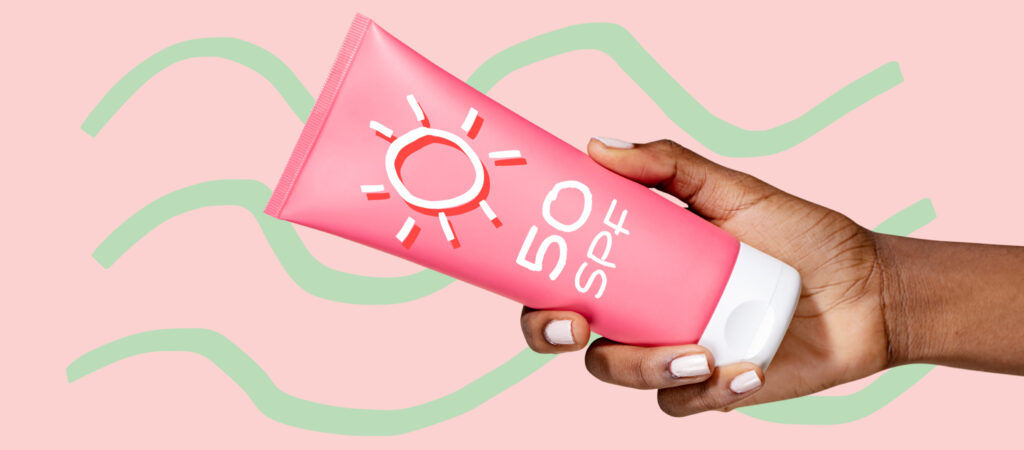The Science of Sun Protection
The Nurx medical team reveals what everyone should know about skin cancer and sun protection — it's a must-read if you're loving the outdoors this summer.

Medically reviewed by Joni Gunzburger, MSN, FNP-C on August 6, 2021
Coming in hot . . your summer reminder that sun safety matters, a lot! Did you know that skin cancer is the most common cancer in the U.S. and worldwide, and that 1 in 5 people will develop it by age 70? To help protect you from this potentially deadly condition, we want to make sure you understand skin cancer and how to prevent it. As a bonus, proper sun protection will also help you avoid a lot of wrinkles, dark spots and other signs of sun-related aging.
Because skin cancer is so common you might not think of it as serious or scary, so I have to tell you that two Americans die of skin cancer every hour of every day. Yep, melanoma, the most serious form of skin cancer, is highly invasive and metastasizes to other parts of your body if it isn’t caught and removed in time. Other skin cancers, basal cell carcinoma and squamous cell carcinoma, grow more slowly than melanoma but still will require potentially disfiguring treatment and lots of follow-up if you do get them.
Skin Cancer Risk Factors
Some people are more at risk of skin cancer than others. Having fair skin or blonde, red, or light brown hair puts you at extra risk. That said, skin cancer affects people of all colors, including those with darker skin tones who always tan or rarely burn. This includes people of African, Asian, Latino, Mediterranean, Middle Eastern and Native American descent. It represents 4-5% of all cancers in Latinx people, 2-4% of cancers in Asians and 1-2% of cancers in Black people.
Nurx offers prescription treatment for acne, anti aging, melasma, rosacea, and eyelash growth.
What’s more, for people of color, it’s often diagnosed late, making it harder to treat. For one thing, there’s a lower public awareness overall of the risk of skin cancer among individuals of color. Second, healthcare providers may not be as concerned about skin cancer in patients of color, so these patients may be less likely to get regular, full-body skin exams. And third, the places on the body where skin cancers tend to occur in people of color are often in less sun-exposed, more out-of-the-way areas — such as the palms of the hands — which makes detection more difficult.
About Basal Cell Carcinoma
Basal cell carcinoma (BCC) is the most common form of skin cancer. An estimated 3.6 million cases of BCC are diagnosed in the U.S. each year. A few facts about this type of cancer:
- Typically easily removed with early detection
- Watch for new, changing or unusual growths in sun exposed areas, such as the face, ears, neck, scalp, shoulders and back.
- Often presents with 2 or more of the below warning signs: An open sore that does not heal, a reddish patch or irritated area, a shiny bump or nodule, a small pink growth, or a scar-like area.
About Squamous Cell Carcinoma
Squamous Cell Carcinoma (SCC) of the skin is also known as cutaneous squamous cell carcinoma (cSCC). Adding the word “cutaneous” identifies it as a skin cancer and differentiates it from squamous cell cancers that can arise inside the body, in places like the mouth, throat or lungs.
- Occurs when DNA damage from exposure to ultraviolet radiation or other damaging agents trigger abnormal changes in the squamous cells
- Less common that BCC
- Signs include a persistent, scaly red patch with irregular borders that sometimes crusts or bleeds, and/or an elevated growth with a central depression that occasionally bleeds. It may rapidly increase in size.
About Melanoma
Melanoma is a serious form of skin cancer that begins in cells known as melanocytes. While it is less common than basal cell carcinoma (BCC) and squamous cell carcinoma (SCC), melanoma is more dangerous because of its ability to spread to other organs more rapidly if it is not treated at an early stage.
Melanocytes are skin cells found in the upper layer of skin. They produce a pigment known as melanin, which gives skin its color. There are two types of melanin: eumelanin and pheomelanin. Naturally darker-skinned people have more eumelanin and naturally fair-skinned people have more pheomelanin. While eumelanin has the ability to protect the skin from sun damage, pheomelanin does not. That’s why people with darker skin are at lower risk for developing melanoma than fair-skinned people who, due to lack of eumelanin, are more susceptible to sun damage, burning and skin cancer.
That said, darker skinned people and those who tan easily can get melanoma too. When skin is exposed to ultraviolet (UV) radiation from the sun or tanning beds, it causes skin damage that triggers the melanocytes to produce more melanin, but only the eumelanin pigment attempts to protect the skin by causing the skin to darken or tan. Melanoma occurs when DNA damage from burning or tanning due to UV radiation triggers changes (mutations) in the melanocytes, resulting in uncontrolled cellular growth.
Melanoma facts and stats:
- 70-80% arise from normal looking skin
- When detected early, the 5-year survival rate for melanoma is 99%
- Darker skin tones are at lower risk for melanoma (but are still at risk)
How to Protect Your Skin
So, now that I’ve reminded you of the very good reasons why you want to protect your skin from the sun, let’s talk about how:
- No surprise: Sunscreen is essential. Regular daily use of SPF 30 or higher reduces risk of developing squamous cell carcinoma by about 40 percent and melanoma about 50%. (More on sunscreen below).
- No matter how diligent you are about applying sunscreen, if you’re spending more than a little time outdoors SPF shouldn’t be your only defense. Wear sun-protective clothing, which doesn’t wear off or need to be reapplied like sunscreen. Look for clothing with a UPF (Ultraviolet Protection Factor) of 50, meaning it allows only 1/50th of UV radiation to reach your skin.
- Wear a wide-brimmed hat (3 inches or more all the way around) and sunglasses that block 99-100% of UVA and UVB rays.
- Seek out the shade of an umbrella, awning or tree, especially during peak hours of 10 AM – 4 PM (though that period may be shorter depending on the time of year and your latitude).
- Don’t use tanning beds. (Just don’t.)
- Keep an eye on your skin to look for any new moles, changes, or anything that just doesn’t look right — when it doubt, get it checked out! And get an annual exam by a dermatologist.
Sunscreen Basics to Memorize
You’ve been using sunscreen for years or even decades, but may not remember (or may choose to forget) the rules for how to choose one and use it right. Here’s a refresher on the basics and a few pieces of info that may be new to you.
- Only use sunscreens labeled broad spectrum, which means they protect against both UVA and UVB rays. In general, UVA rays cause skin aging and UVB rays cause sunburn.
- Choose a minimum of SPF 30 and pick a water-resistant formula. SPF means “Sun Protection Factor” and refers to how much longer it would take UVB rays to darken or redden your skin vs if you were wearing no protection. So, wearing SPF 30 means it will take 30 times longer for skin to burn than without sunscreen.
- To prevent acne look for the words “non-comedogenic,” meaning it won’t clog pores.
- Use a full ounce (think a shot glass-full) for your body and a teaspoon (think a quarter or a grape) for your face.
- Apply sunscreen 30 minutes before going outdoors, and don’t forget to reapply every 2 hours or after swimming or sweating.
Chemical vs Physical Sunscreens
While the sunscreen shelves are overflowing with options, there are two broad categories: “chemical” and “physical” sunscreens. Chemical blockers work by absorbing UV rays when they hit your skin, and contain active ingredients such as aminobenzoic acid, avobenzone, octisalate, octocrylene, and oxybenzone. These sunscreens usually blend easily with no pastiness.
Physical sunscreens, also sometimes called mineral sunscreens, stay on the surface of your skin and deflect UV rays. The active ingredients are zinc oxide and/or titanium dioxide. These are often better for people with sensitive skin and/or rosacea.
You may have seen headlines about benzene in sunscreens. A new study by an independent lab called Valisure tested 200+ sunscreens and found measurable amount of Benzene in many. Benzene is a known carcinogen and the FDA is currently investigating. Here is a list of sunscreens that Valisure found to not contain benzene. Research is ongoing, so this is not an indication to stop using sunscreen– just a reminder to do your research and choose a product that is best for YOU.
Nurx doctors recommend two affordable sunscreens: Solbar Fifty SPF 50, a chemical formula, and Alba Botanica Mineral Sunscreen SPF 45, a physical sunscreen.
Sun Exposure and Prescription Skin Treatments
If you take a prescription skin medication such as antibiotics for acne or rosacea, or tretinoin for acne or anti-aging, you need to be especially careful about sun protection as these medications can make your skin more sensitive to the sun.
Learn More
For even more in-depth education about about skin cancer and sun protection, visit these online resources:
American Academy of Dermatology



